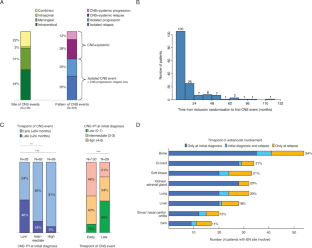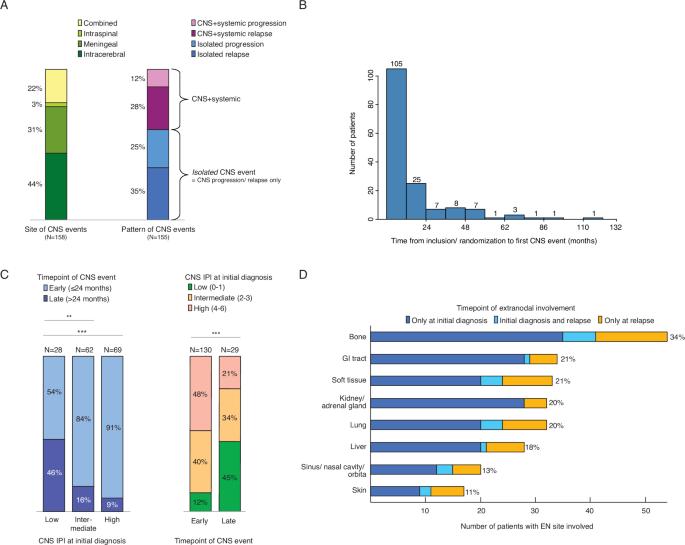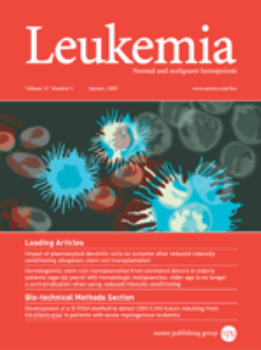Identification, risk factors, and clinical course of CNS relapse in DLBCL patients across 19 prospective phase 2 and 3 trials—a LYSA and GLA/ DSHNHL collaboration
IF 12.8
1区 医学
Q1 HEMATOLOGY
引用次数: 0
Abstract
Progression or relapse in the central nervous system (CNS) remains a rare but mostly fatal event for patients with diffuse large B-cell lymphoma (DLBCL). In a retrospective analysis of 5189 patients treated within 19 prospective German and French phase 2/3 trials, we identified 159 patients experiencing a CNS event (relapse: 62%, progression: 38%). Intracerebral, meningeal, intraspinal, or combined involvement was reported in 44%, 31%, 3%, and 22% of patients, respectively. 62 of 155 evaluable patients (40%) showed concurrent systemic progression/ relapse. 82% of all CNS events occurred within two years after study inclusion or randomization. 87% of patients showed extranodal involvement outside the CNS. Patients generally had poor outcomes with a median overall survival (OS) of 3.4 months (95% CI 2.9–4.2) and a 2-year OS of 15% (10–22%). Outcomes did not differ depending on the site or time point of CNS events. Patients with isolated CNS events demonstrated significantly better OS (p = 0.023). Twenty-five patients were consolidated with autologous or allogeneic stem cell transplantation and achieved a 3-year OS of 36% (20–66%). This large study including more than 5000 DLBCL patients highlights the unmet medical need to improve the outcome of DLBCL patients suffering from CNS relapse.


19项前瞻性2期和3期试验中DLBCL患者中枢神经系统复发的识别、风险因素和临床过程--LYSA和GLA/DSHNHL合作项目
对于弥漫大 B 细胞淋巴瘤(DLBCL)患者来说,中枢神经系统(CNS)的进展或复发仍然罕见,但大多是致命的。在对19项德国和法国前瞻性2/3期试验中接受治疗的5189名患者进行的回顾性分析中,我们发现159名患者出现了中枢神经系统事件(复发:62%,进展:38%)。脑内、脑膜、椎管内或合并受累的患者比例分别为 44%、31%、3% 和 22%。在 155 例可评估的患者中,62 例(40%)同时出现全身进展/复发。82%的中枢神经系统事件发生在纳入研究或随机分配后两年内。87%的患者出现中枢神经系统以外的结节外受累。患者的预后普遍较差,中位总生存期(OS)为3.4个月(95% CI为2.9-4.2),2年OS为15%(10-22%)。中枢神经系统事件发生的部位或时间点不同,结果也不尽相同。发生孤立中枢神经系统事件的患者的 OS 明显更好(p = 0.023)。25名患者接受了自体或异体干细胞移植,3年生存率为36%(20-66%)。这项包括5000多名DLBCL患者的大型研究强调,改善中枢神经系统复发的DLBCL患者预后的医疗需求尚未得到满足。
本文章由计算机程序翻译,如有差异,请以英文原文为准。
求助全文
约1分钟内获得全文
求助全文
来源期刊

Leukemia
医学-血液学
CiteScore
18.10
自引率
3.50%
发文量
270
审稿时长
3-6 weeks
期刊介绍:
Title: Leukemia
Journal Overview:
Publishes high-quality, peer-reviewed research
Covers all aspects of research and treatment of leukemia and allied diseases
Includes studies of normal hemopoiesis due to comparative relevance
Topics of Interest:
Oncogenes
Growth factors
Stem cells
Leukemia genomics
Cell cycle
Signal transduction
Molecular targets for therapy
And more
Content Types:
Original research articles
Reviews
Letters
Correspondence
Comments elaborating on significant advances and covering topical issues
 求助内容:
求助内容: 应助结果提醒方式:
应助结果提醒方式:


